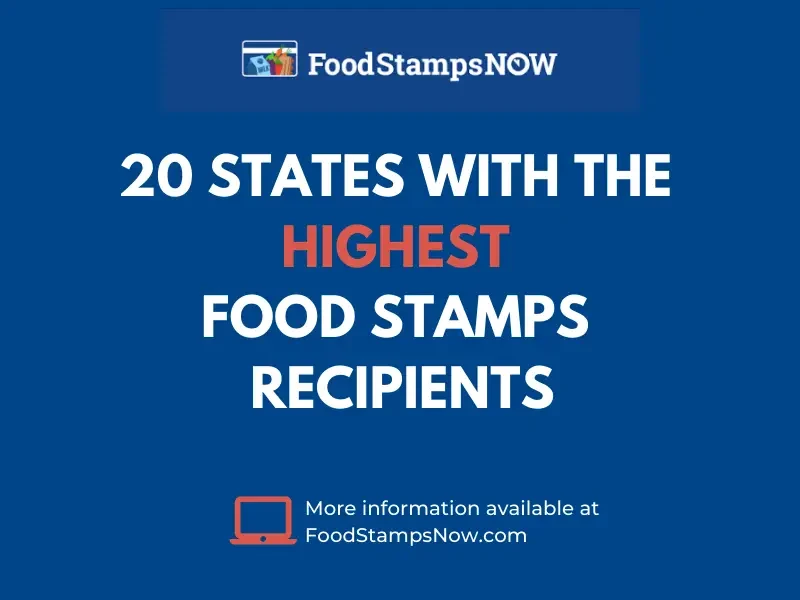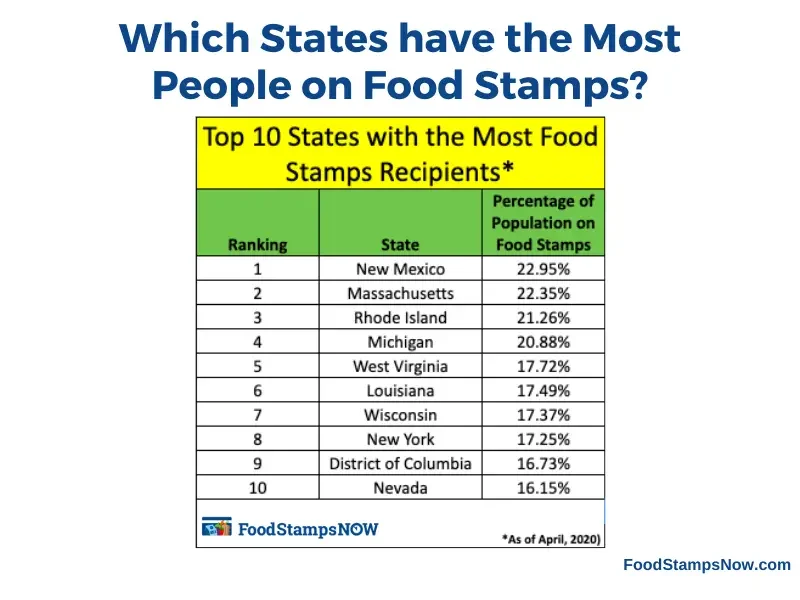Last updated on 9/10/20
The food stamps program helps feed millions of Americans, many of whom are children, the elderly, or disabled. There is always controversy around the food stamps program, especially during election years. In this post, we will highlight the top 20 states with high food stamps recipients.
Nationwide, 13.1% of Americans rely on food stamps, as of April 2020.
However, in some states, the percentage of recipients is far higher.
With the rapid rise in the unemployment rate, that is no surprise.
Looked at the population of each state as of 2019 and compared it to the most recent food stamps data as of the time of writing this article (April 2020) and came up with the top 20 states with the most people on food stamps.
See below for our list.

However, before you review the data, a brief summary of the food stamps program is necessary, so that you have context when you review the top 20 list below.
Food Stamps Program Explained
The food stamps program (SNAP benefits) is a federal nutrition program that helps millions of low-income Americans put food on the table.
Most families and individuals who meet the program’s income guidelines are eligible for benefits.
More than two-thirds of SNAP participants are in families with children; a third are in households with seniors or people with disabilities.
Outside of unemployment insurance, the food stamps program is the most responsive federal program providing additional assistance during economic downturns.
How much each individual or family receives in benefits is based on its income and certain expenses.
The average individual benefit is $182 per month, while the average household benefit is $351 per month as of April 2020.
How Many People are on Food Stamps?
Across the United States, there were close to 43 million individuals and 22 million households receiving SNAP benefits as of April 2020.
The federal government pays the full cost of the food stamps program and splits the cost of administering the program with the states, which operate the program.
How Much Does the Food Stamps program Cost?
In the fiscal year 2019, the food stamps program cost the federal government $65.4 billion on.
Of the total amount, $60.9 billion was spent directly on benefits to households to purchase food.
The other $4.5 billion went to state administrative costs, including eligibility determinations, employment and training, and nutrition education for SNAP households, and anti-fraud activities.
Who is Eligible for Food Stamps?
Households must earn less than 130% of the poverty level (gross income), or a net income amount less than 100% of the poverty level for their family size, to qualify for food stamps.
For 2020, here are the income limits for the food stamps program based on household size:
| Household Size | Maximum Gross Monthly Eligibility Standard | Maximum Net Monthly Income Eligibility Standard |
| 1 | $1,354 | $1,041 |
| 2 | $1,832 | $1,410 |
| 3 | $2,311 | $1,778 |
| 4 | $2,790 | $2,146 |
| 5 | $3,269 | $2,515 |
| 6 | $3,748 | $2,883 |
| 7 | $4,227 | $3,251 |
| 8 | $4,705 | $3,620 |
| Each Additional Member |
$479 | $369 |
Food Stamps Work Requirements
The food stamps program has SNAP has two sets of work requirements:
If you are age 16 – 59 and able to work, you will probably need to meet the general work requirements to get SNAP benefits.
The general work requirements include registering for work, participating in SNAP Employment and Training (E&T) or workfare if assigned by your state SNAP agency, taking a suitable job if offered, and not voluntarily quitting a job or reducing your work hours below 30 a week without a good reason.
In addition, Able-Bodied Adult Without Dependents (ABAWD) must meet additional requirements.
If you are age 18 – 49, able to work, and don’t have any dependents, you might need to meet both the general work requirements and an additional work requirement for ABAWDs to get SNAP for more than 3 months in 3 years (the time limit).
20 States with the Highest Food Stamps Recipients
To arrive at our list of the top 20 states with the highest food stamps recipients, we compared the USDA’s most recent state-by-state data (as of April 2020) with the latest population data from the Census Bureau.
Here are the top 20 states in descending order:
20. Tennessee
Percentage of people on food stamps: 13.18%
The number of people on food stamps: 900,106
The population of Tennessee: 6,829,174
19. Kentucky
Percentage of people on food stamps: 13.26%
The number of people on food stamps: 592,538
The population of Kentucky: 4,467,673
18. Arizona
Percentage of people on food stamps: 13.65%
The number of people on food stamps: 993,751
The population of Arizona: 7,278,717
17. Pennsylvania
Percentage of people on food stamps: 14.40%
The number of people on food stamps: 1,843,929
The population of Pennsylvania: 12,801,989
16. Florida
Percentage of people on food stamps: 14.54%
The number of people on food stamps: 3,123,525
The population of Florida: 21,477,737
15. Alabama
Percentage of people on food stamps: 15.09%
The number of people on food stamps: 739,950
The population of Alabama: 4,903,185
14. Illinois
Percentage of people on food stamps: 15.22%
The number of people on food stamps: 1,929,163
The population of Illinois: 12,671,821
13. Mississippi
Percentage of people on food stamps: 15.35%
The number of people on food stamps: 456,724
The population of Mississippi: 2,976,149
12. Oklahoma
Percentage of people on food stamps: 15.49%
The number of people on food stamps: 612,779
The population of Oklahoma: 3,956,971
11. Oregon
Percentage of people on food stamps: 15.77%
The number of people on food stamps: 665,156
The population of Oregon: 4,217,737
10. Nevada
Percentage of people on food stamps: 16.15%
The number of people on food stamps: 497,313
The population of Nevada: 3,080,156
9. District of Columbia
Percentage of people on food stamps: 16.73%
The number of people on food stamps: 118,070
The population of District of Columbia: 705,749
8. New York
Percentage of people on food stamps: 17.25%
The number of people on food stamps: 3,354,912
The population of New York: 19,453,561
7. Wisconsin
Percentage of people on food stamps: 17.37%
The number of people on food stamps: 1,011,159
The population of Wisconsin: 5,822,434
6. Louisiana
Percentage of people on food stamps: 17.49%
The number of people on food stamps: 812,957
The population of Louisiana: 4,648,794
5. West Virginia
Percentage of people on food stamps: 17.72%
The number of people on food stamps: 317,622
The population of West Virginia: 1,792,147
4. Michigan
Percentage of people on food stamps: 20.88%
The number of people on food stamps: 2,085,651
The population of Michigan: 9,986,857
3. Rhode Island
Percentage of people on food stamps: 21.26%
The number of people on food stamps: 225,202
The population of Rhode Island: 1,059,361
2. Massachusetts
Percentage of people on food stamps: 22.35%
The number of people on food stamps: 1,540,693
The population of Massachusetts: 6,892,503
1. New Mexico
Percentage of people on food stamps: 22.95%
The number of people on food stamps: 481,136
The population of New Mexico: 2,096,829

States with the highest food stamps recipients Summary
We hope this article on states with the highest food stamps recipients was helpful.
If so, we encourage you to share this article with anyone who may also find it helpful by using the “Share this” button below.
If you have additional questions about the food stamps benefits, please leave those in the comments section below. We are here to help you!
Be sure to check out our other articles about SNAP Benefits, including Low-Income Government Lifeline Cell Phones, 50% OFF Amazon Prime for Food Stamps and Medicaid Cardholders, and Coronavirus help for Low-Income Americans.
